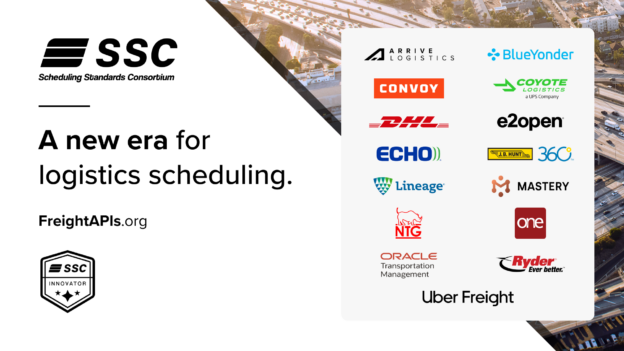The Fastest Path to Autonomous Trucking
Industry Insights • Published on May 3, 2022
This story originally appeared in Convoy’s “The Future of Freight,” featuring 40 thoughtfully curated pages on supply chain disruption, freight procurement, market volatility, and more.

Autonomous trucking continues to be one of the hottest topics in freight. The most practical way for self-driving to work in trucking is for the driver to stay in the truck throughout the job, handing driving responsibilities to the autonomous truck on highways in order to rest and reset their hours-of-service, just like team-driver pairs do today. Here’s how.
In late 2019, the cost to ship a truckload of boxed macaroni and cheese from Los Angeles to Seattle was about $2,100. Today, that same delivery costs $4,500, up 115% in two years. This is because demand for physical goods has surged during the pandemic, but there aren’t enough available drivers or trucks and trailers to fulfill this demand. According to the American Trucking Association, the United States is short 80,000 drivers today. Adding to this challenge is that the production of new trucks and trailers is only meeting about 70% of orders due to materials and labor shortages, according to manufacturers. Whatever the numbers, trucking capacity is constrained today and will be again in the future.
The immediate way to create capacity is to orchestrate the system so that truck drivers are as productive as possible. Today, about one-third of the time trucks run empty, and drivers sit idle at facilities for hours because of congestion, suboptimal appointment times, or warehouse constraints on loading or unloading. Additionally, life as a truck driver can be stressful, from slow or delayed payments-for-work to the daily challenge of finding overnight parking. These issues hurt productivity, increase costs, and make trucking less attractive for drivers. These are the problems that Convoy is working on today.

Self-driving is the next major opportunity to address these issues. First, it will increase capacity. The U.S. Department of Transportation’s (DOT) hours-of-service (HOS) regulations keep the roads safer, but these laws limit truck drivers to 11 hours of driving per day. Autonomous trucks, without these HOS constraints, could make deliveries in half the time, doubling productivity, reducing costs and nights on the road, and adding capacity to the freight industry.
Second, self-driving technology can improve driver retention. Driver-assist technology is already reducing stress on drivers, and with Level 4+ autonomy, drivers will be able to multitask in the cab and expand their roles into maintenance planning, customer service, etc., creating new career paths. Additionally, with more trucks able to run autonomously at night, overnight parking capacity will increase, making it easier for those who need parking to find it and removing a major source of anxiety for drivers.
Self-driving has been touted as the future for a decade now, so how is this different? Most of what happened before was related to ride-sharing and robo-taxis in and around cities, which are very difficult for autonomous systems to reliably navigate. Conversely, for trucking, most jobs have a major on-highway portion to them. There is enough upside in trucking that it is worth investing in solutions for the highway leg of the trip alone. In these trucking scenarios, humans will drive the first- and last-mile portions of the run, navigating urban areas and people at warehouses and other facilities, and the truck will drive itself on the highway. Therefore, the key is to build a system that supports hand-offs between autonomous trucks and human drivers.
There are a few ways that this could happen, each with its own set of regulatory requirements and operational challenges. How this plays out will impact whether or not we realize the benefits of self-driving anytime soon or not. Let’s get onto it.
The transfer hub model

Conventional thinking is that in order for self-driving trucks to reduce the cost of trucking, there shouldn’t be a paid driver onboard for the autonomous portion of the trip. This leads to the plan for self-driving that we hear most often: the transfer hub model. In this model, a local driver drops a loaded trailer at a “hub,” typically located outside of a city by the highway. A self-driving truck transports that trailer autonomously along the highway portion of the run, dropping it off at a hub near the destination city. From there, another local driver picks it up and takes it to the final delivery location.
The benefit of this model is that for very long highway runs, the cost savings of not paying anyone to be in the cab could offset the additional infrastructure cost of building and operating hubs and running local deliveries. Additionally, with high levels of consistent volume, the network could become very efficient and halo effects may emerge, such as local drivers becoming experts on local routes.
However, there are several practical reasons why this model isn’t the best place to begin.
1. It would increase the chances of delays and operational disruptions, especially before autonomous trucking is widely adopted.
- Every additional stop and every trailer handoff during a job increases the risk that the delivery will not be made on time. The transfer hub model has double the stops and hand-offs of a point-to-point job.
- The requirement to visit a hub on each end of the journey reduces route flexibility and the options for a driver to navigate in the most efficient way possible.
- Even on highway portions, a driver may still be needed to navigate off-highway detours, inclement weather, construction zones, weigh stations, etc. Do the trucks just pull over and wait for an emergency operator to arrive?
2. It will take a lot of upfront capital and coordination to set up an efficient, bottleneck-proof operation with route flexibility.
- To allow trucks to avoid traffic or delays at a facility, each region will need many shared transfer locations.
- A single carrier running their own transfer hubs will need less capital and be less operationally efficient than 3PLs operating shared hubs. Shared hubs will require coordination between competing carriers.
- Without shared hubs, hundreds of thousands of small carriers and owner-operators won’t be able to engage.
- These hubs would be expensive to set up and operate.
- Hubs would become a new potential chokepoint for the system.
3. It requires that logistics planning teams switch to a new model with new risks.
- It is a new model with a cold-start problem. It is harder than using autonomy to enhance the existing point-to-point system.
- The industry is fragmented so it will be hard to coordinate a broad transition to this model. Proving it works sub-scale will also be a challenge.
- It will require a lot of paperwork and risk management. Today, a single carrier is responsible for moving each load end to end. In a transfer hub model, at least three different drivers would take possession of the freight, creating additional liability and requiring additional approvals.
There is a better way to launch autonomous trucking that fits the current framework, does not require scale, and allows America’s millions of small carriers, owner-operators, and truck drivers to participate at the same level as larger carriers. This way delivers nearly all of the benefits of the transfer hub model without the issues. It is also compatible with today’s system of point-to-point truckload deliveries and is based on the existing team-driver model.
We are calling it the autonomous tag-team model.
The autonomous tag-team model
The DOT’s HOS regulations limit truck drivers to 11 driving hours after 10 consecutive hours off duty. Today, when a load needs to be delivered more quickly, two-person driver teams work together, alternating who is driving and who is offduty, so they can refresh their hours en route and cover nearly twice as much ground per day as a single driver. This is more expensive, but it allows for much faster transit times (HOS rules summary).
We propose that this model, with one of the drivers in the team being the autonomous truck, is the safest, fastest, most driver-friendly way to quickly realize the benefits of self-driving trucks once the technology is approved. This is similar to an airplane’s autopilot system partnering with a human pilot. The truck would navigate the highway portions, during which the driver would be off duty, resting and resetting their HOS. For the first- and last-mile portions of the run, or whenever the truck is unable to operate autonomously on the highway, the driver would take over.
This is a practical, walk-before-you-run model. It can start without any changes to the existing point-to-point routes that drivers use today and will allow regional and long-haul runs to be completed in nearly half the time. This would quickly add a large amount of new trucking capacity to our economy while helping drivers make more money, stay productive, and maintain their livelihoods.
Approval of this model should happen in parallel to when DOT and state regulators deem self-driving trucks safe enough to operate on public highways around other vehicles without a driver onboard. At that point, by definition, it will be safe for an off-duty driver to be inside the truck. This is exactly the same as today’s team-driving model, with the truck filling the role of the second driver.
Cost comparison
The autonomous tag-team model has fewer operational hurdles, but is it more expensive? The short answer is no. It is less expensive for runs under about 1,500 miles and for very long distances, the costs are similar.
Consider this scenario: A 900-mile dry van run pays the trucking company $2,700. A single driver could complete the run in two days and would be paid about $500. Done with an autonomous truck, the run could instead be completed in just one day. How do the different approaches stack up to this?
Transfer hub: In the transfer hub approach, no driver is paid for the highway portion. However, paying the hub operator for local pickups and deliveries would likely add $200 each, or $400 total.
Autonomous tag team: For a one-day run, the tag-team driver could make about $300, a bit more than the per-day rate of a traditional, manual job. This model costs $100 less than the transfer hub approach for this job, not including additional miles driven.
If the job were longer, say 2,000 miles paying $5,000, the greater highway distance makes the no-driver transfer hub model lower cost, but only by about $170, or 3% of the total job. That said, this does not factor in other hard-to-predict costs such as roadside assistance for when the autonomous trucks need human support, extra miles driven to the transfer hub, or any additional delays that result from the trailer being transferred twice versus running straight through. These would potentially offset any cost advantage.
Net-net, the autonomous tag-team approach is the best approach. It offers the same speed-of-delivery advantages without the operational complexities and service risks of a transfer hub, for about the same cost. It also keeps drivers in the truck, supporting their livelihood and allowing drivers’ roles to expand as broader freight operators on the road.
And because of the existing team-driver model, as long as trucks are allowed to operate fully autonomously, human drivers should be able to team-drive with them as soon as the technology reaches Level 4, with minimal new regulatory work or operational changes to allow that to happen.
Closing
We hear questions from industry executives and regulators about how self-driving will take shape. In the long run, these two models will likely both exist and complement each other based on different delivery scenarios, e.g., trading off speed, distance, and cost, but the tag-team model is the right one to start with.
This is a list of things that will need to be clarified for the tag-team model to work:
- Autonomous technology must be ready for general use by trucks on public highways (i.e., under what conditions will trucks be allowed to run without an engaged human behind the wheel, and who decides this at what level, etc.)?
- Is the human team member off duty when the self-driving technology is operating the vehicle, just as if another human were driving?
- Where can the driver be during this period, in the front seat, cab, etc., and what other limitations exist (e.g., like the split sleeper berth rule)?
- Can a driver refuel their truck (or plug it into a charger) during off-duty hours?
- Under what circumstances can the autonomous truck request the off-duty driver’s assistance without interrupting their off-duty hours?
- What, if any, transfer of risk and liability from carriers and drivers to the self-driving technology company will be needed when the truck is in autonomous mode?
No matter which model is used, as self-driving trucks enter the market, we will see years of mixed fleets containing traditional and autonomous trucks of varying degrees, as well as mixed rules and regulations for fleet operators to follow. Whether a truck can drive autonomously will vary by its technology, location, current weather conditions, traffic situations, etc. Today, every truck has the same hours of service, but in the autonomous world, it will vary based on these and other factors, making it more difficult to match the right load to the right truck. Doing this effectively will require technology and machine-learning based systems to consider all of the new variables and optimize trucking. In short, things will get more complicated before they get simpler, and it will take digital, AI-driven freight platforms to make sense of all these new variables and optimize this more complex system. This will provide a big opportunity for technology platforms such as Convoy.



